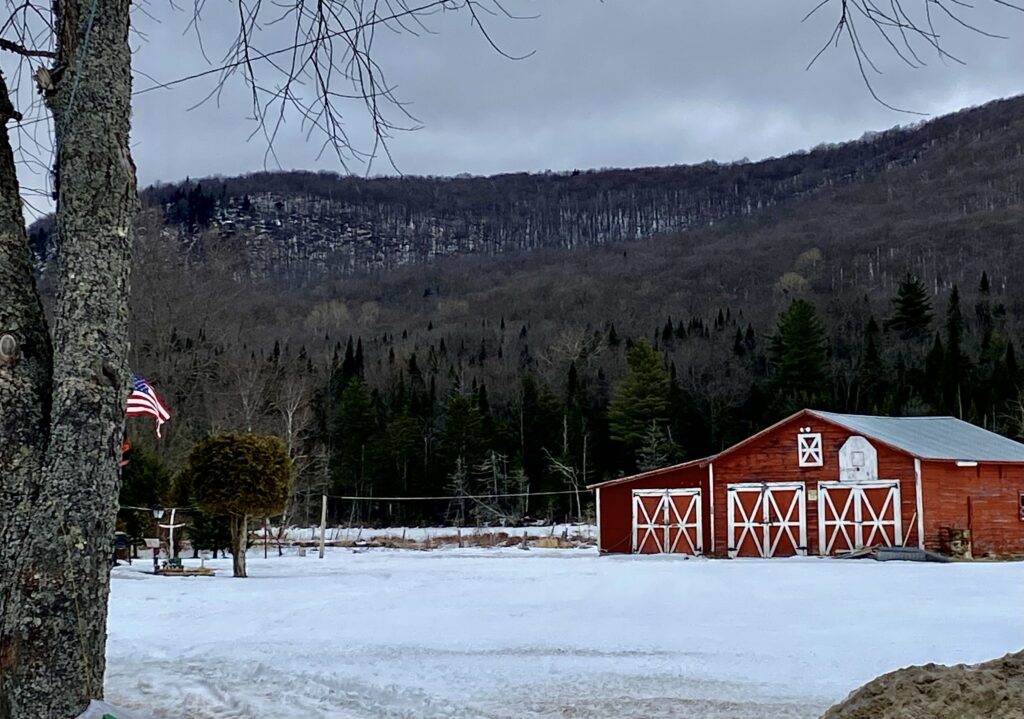Icebox
I am packing my snowshoes and trail crampons, but I am half inclined to bring along my swim fins as well. Kidding aside, this morning, after a night of heavy rain followed by a day of above-freezing temperature, I woke up to a yard of brownish grass. We are going, allegedly, to snowshoe up Owls Head Mountain, southeast of Malone, New York, curiously one of at least four mountains in the Adirondacks bearing the same name. Given this unusually mild February, I am just not sure if the trail will be covered in snow, mud, or water.
As we drive across the border, I am not at all optimistic. Other than the odd smidgen of week-old snow in the shadowed woods, there is very little white gracing the ground. The sight of a green golf course past our halfway mark only makes my spirit sink further. But then, as we approach the hamlet of Owls Head, I am astounded by the transformed landscape; A magic wand has seemingly covered the land with a thickening blanket of snow. If I had realized that this area was once dubbed the “Icebox” of New York for being the coldest spot in the state, I may not have worried so much. Based on scientific fact or not, I am a believer!
The snow on the mountain is not fresh by any means, but it is plentiful and that is good enough for me. The hike is a four-kilometer round trip, and the ascent is mostly gradual. It is an ideal mountain hike for beginners or people like us looking for a leisurely climb on a Sunday morning. Don’t think that the beautiful summit view is the only incentive to strap on your snowshoes. This little mountain has an additional noteworthy site to visit. Just before the steepest section, a little past the main trail, is an abandoned mine from the late 1800s where ore was once excavated. A considerable amount of water streams down over the rocks above the shaft and in the winter, it freezes into an impressive waterfall monument while the shaft floor itself sprouts ice stalagmites. Perhaps this is the nucleus of Owls Head’s icebox. It certainly looks like the most glacial place on the mountain.
Once back on the main trail, the real ascent begins. While somewhat steep, it is a relatively short climb compared to other mountains. Within a few minutes, we are at the summit and have a clear view of the mountains and the frozen Mountain View Lake below. It is a lovely spot to kick off our snowshoes for a while and enjoy a meal on the rocks. However, we must first bundle up as the open summit is quite breezy. We don’t mind though, because we are at the top of the world gazing across at the purple high peaks in the distance and into the beautiful valley below us. In the distance, we spot the red barn near our departure point. From here it reminds me of the classic toy barn of my youth, which, coincidentally, also sported a white “x” on each door. No matter, how many times I come here, I never fail to photograph that structure. There is just something nostalgic about a bright red barn in an open field. Surpassing the view, if that is possible, is the knowledge that there are no other souls around. We have the entire mountain to ourselves, and assuming every visitor has signed the trail register, no one has been here in several days.
Regrettably, the time to descend has come. I take a last look, trying to imprint the vista in my mind to make it last a little longer, because a photograph, as good as it might be, fails to capture the whole scene. With a heart filled with gratitude, I turn my back on the valley, and start the journey down, embracing my surroundings with mindfulness. It is odd how once the anticipation of the climb is satisfied, the descent, despite being the same distance, always seems so much shorter. Already, we are back to the life-size barn, and it is time to load up the car and leave, but we will be back next year, same time, same mountain. After all, we must make sure the presumed icebox will remain cold to honor its reputation.





